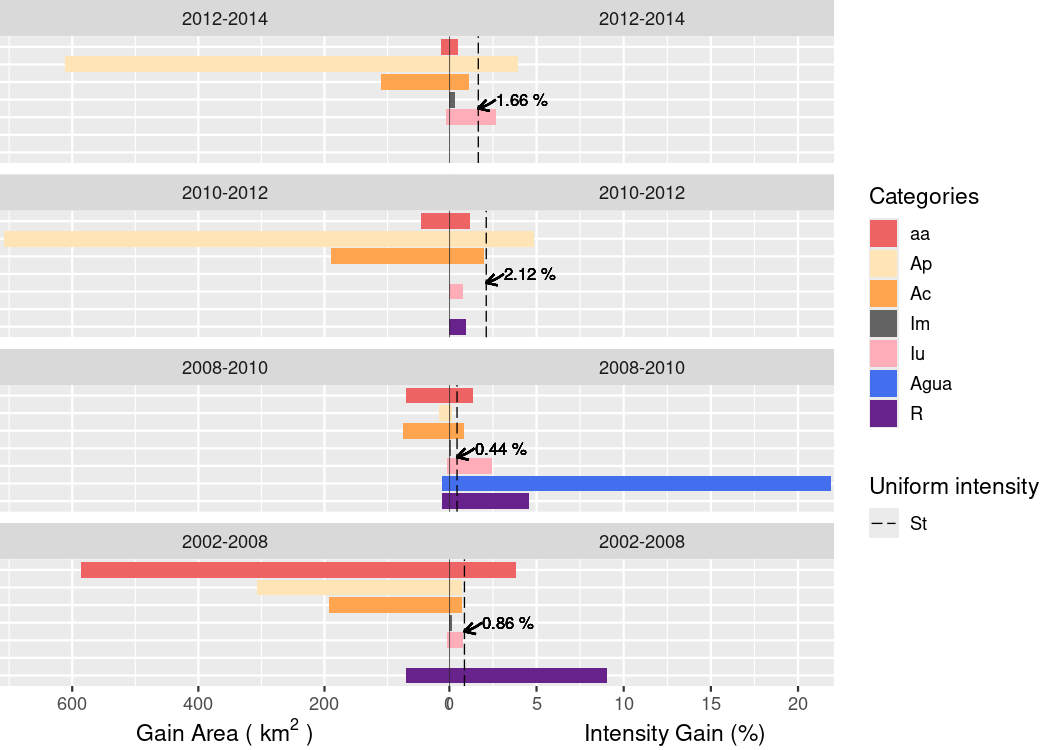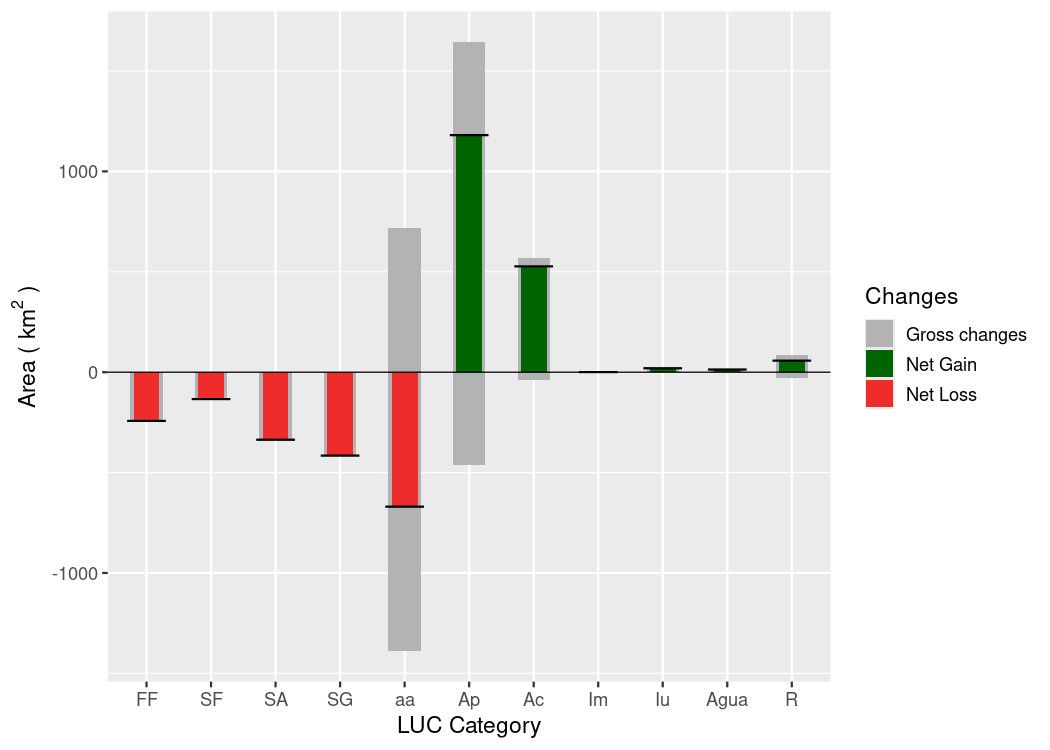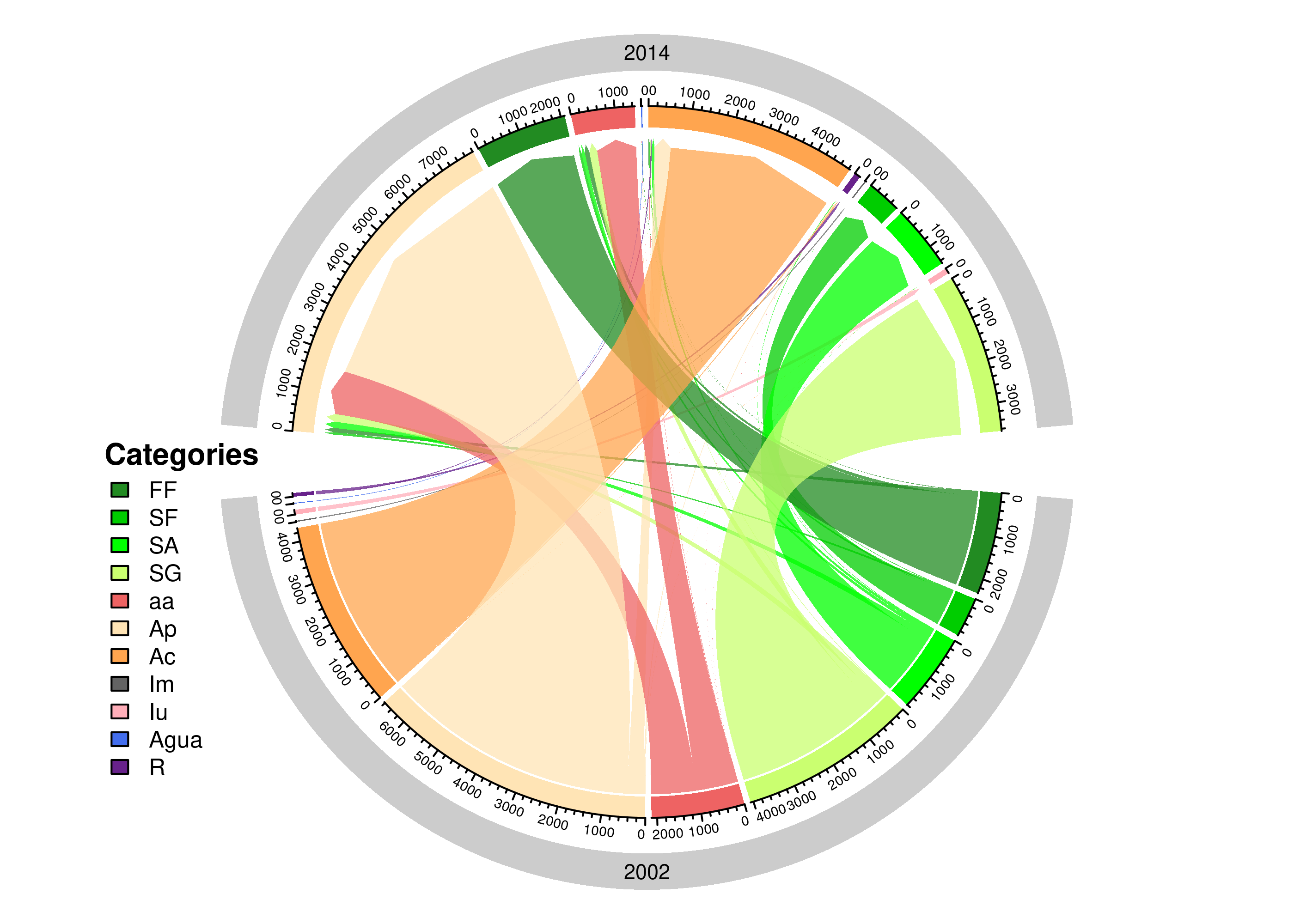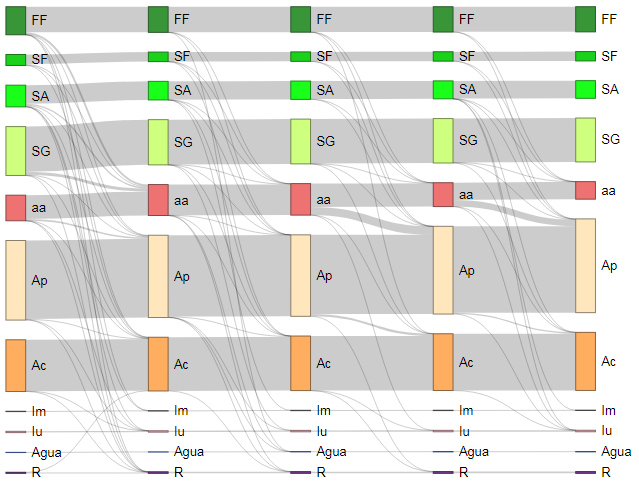OpenLand is an open-source R package for the analysis of land use and cover (LUC) time series. It includes support for consistency check and loading spatiotemporal raster data and synthesized spatial plotting. Several LUC change (LUCC) metrics in regular or irregular time intervals can be extracted and visualized through one- and multistep sankey and chord diagrams. A complete intensity analysis according to (Aldwaik and Pontius 2012) is implemented, including tools for the generation of standardized multilevel output graphics.
Install the released version of OpenLand from CRAN:
install.packages("OpenLand")Or install the development version from GitHub with:
# install.packages("devtools")
devtools::install_github("reginalexavier/OpenLand")This is a basic example which shows how OpenLand works, for a more detailed illustration, please see our vignettes.
The OpenLand functionality is illustrated for a LUC dataset of São
Lourenço river basin, a major Pantanal wetland contribution area as
provided by the 4th edition of the Monitoring of Changes in
Land cover and Land Use in the Upper Paraguay River Basin - Brazilian
portion - Review Period: 2012 to
2014 (Embrapa
Pantanal, Instituto SOS Pantanal, and WWF-Brasil 2015). The time series
is composed by five LUC maps (2002, 2008, 2010, 2012 and 2014). The
study area of approximately 22,400 km2 is located in the
Cerrado Savannah biom in the southeast of the Brazilian state of Mato
Grosso. For processing in the OpenLand package, the original multi-year
shape file was transformed into rasters and then saved as a 5-layer
RasterStack (SaoLourencoBasin), available from a public repository
(10.5281/zenodo.3685229) as an
.RDA file which can be loaded into R.
# Loading the package
library(OpenLand)Intensity Analysis (IA) is a quantitative method to analyze LUC maps at several time steps, using cross-tabulation matrices, where each matrix summarizes the LUC change at each time interval. IA evaluates in three levels the deviation between observed change intensity and hypothesized uniform change intensity. Hereby, each level details information given by the previous analysis level. First, the interval level indicates how size and rate of change varies across time intervals. Second, the category level examines for each time interval how the size and intensity of gross losses and gross gains in each category vary across categories for each time interval. Third, the transition level determines for each category how the size and intensity of a category’s transitions vary across the other categories that are available for that transition. At each level, the method tests for stationarity of patterns across time intervals (Aldwaik and Pontius 2012).
The data is extracted from the rasters with the
contingencyTable()
function which returns a multiple grid information in tables for the
next processing steps. Within the OpenLand package, the
intensityAnalysis()
function computes the three levels of analysis. It requires the object
returned by the contingenceTable() function and that the user
predefines two LUC categories n and m. Generally, n is a target
category which experienced relevant gains and m a category with
important losses.
my_test <- intensityAnalysis(dataset = SL_2002_2014, # here the outcome from the `contingenceTable()` function
category_n = "Ap", category_m = "SG")
# it returns a list with 6 objects
names(my_test)
#> [1] "lulc_table" "interval_lvl" "category_lvlGain"
#> [4] "category_lvlLoss" "transition_lvlGain_n" "transition_lvlLoss_m"The intensityAnalysis() function returns 6 objects: lulc_table,
interval_lvl, category_lvlGain, category_lvlLoss, transition_lvlGain_n,
transition_lvlLoss_m. Here, we adopted an object-oriented approach that
allows to set specific methods for plotting the intensity objects.
Specifically, we used the S4 class, which requires the formal definition
of classes and methods (Chambers 2008).
In this example we will show an object from Category class. A
Category object contains three slots: the first contains the colors
associated with the legend items as name attributes, the second slot
contains a table of the category level result (gain
(Gtj) or loss (Lti) values) and the third slot
contains a table storing the results of a stationarity test.
my_test$category_lvlGain
#> An object of class "Category"
#> Slot "lookupcolor":
#> Ap FF SA SG aa SF Agua Iu
#> "#FFE4B5" "#228B22" "#00FF00" "#CAFF70" "#EE6363" "#00CD00" "#436EEE" "#FFAEB9"
#> Ac R Im
#> "#FFA54F" "#68228B" "#636363"
#>
#> Slot "categoryData":
#> # A tibble: 23 × 6
#> # Groups: Period, To [23]
#> Period To Interval GG_km2 Gtj St
#> <fct> <fct> <int> <dbl> <dbl> <dbl>
#> 1 2012-2014 aa 2 14.9 0.510 1.66
#> 2 2012-2014 Ap 2 612. 3.92 1.66
#> 3 2012-2014 Ac 2 110. 1.14 1.66
#> 4 2012-2014 Im 2 0.195 0.337 1.66
#> 5 2012-2014 Iu 2 6.79 2.67 1.66
#> 6 2010-2012 aa 2 47.0 1.18 2.12
#> 7 2010-2012 Ap 2 707. 4.84 2.12
#> 8 2010-2012 Ac 2 189. 2.00 2.12
#> 9 2010-2012 Iu 2 1.90 0.792 2.12
#> 10 2010-2012 R 2 2.76 0.951 2.12
#> # ℹ 13 more rows
#>
#> Slot "categoryStationarity":
#> # A tibble: 12 × 5
#> To Gain N Stationarity Test
#> <fct> <int> <int> <chr> <chr>
#> 1 aa 2 4 Active Gain N
#> 2 Ap 2 4 Active Gain N
#> 3 Ac 1 4 Active Gain N
#> 4 Iu 2 4 Active Gain N
#> 5 Agua 1 4 Active Gain N
#> 6 R 2 4 Active Gain N
#> 7 aa 2 4 Dormant Gain N
#> 8 Ap 2 4 Dormant Gain N
#> 9 Ac 3 4 Dormant Gain N
#> 10 Im 3 4 Dormant Gain N
#> 11 Iu 2 4 Dormant Gain N
#> 12 R 1 4 Dormant Gain NVisualizations of the IA results are obtained from the
plot(intensity-object) function. For more details on the function
arguments, please see the documentation of the
plot()
method.
plot(my_test$category_lvlGain,
labels = c(leftlabel = bquote("Gain Area (" ~km^2~ ")"),
rightlabel = "Intensity Gain (%)"),
marginplot = c(.3, .3), labs = c("Categories", "Uniform intensity"),
leg_curv = c(x = 1, y = .5),
fontsize_ui = 8)OpenLand provides a bench of visualization tools of LUCC metrics. One-step transitions can be balanced by net and gross changes of all categories through a combined bar chart. Transitions between LUC categories can be detailed by a circular chord chart, based on the Circlize package (Gu et al. 2014). An implementation of Sankey diagram based on the networkD3 package (Allaire et al. 2017) allow the representation of one- and multistep LUCC between categories. Areal development of all LUC categories throughout the observation period can be visualized by a grouped bar chart.
netgrossplot(dataset = SL_2002_2014$lulc_Multistep,
legendtable = SL_2002_2014$tb_legend,
xlab = "LUC Category",
ylab = bquote("Area (" ~ km^2 ~ ")"),
changesLabel = c(GC = "Gross changes", NG = "Net Gain", NL = "Net Loss"),
color = c(GC = "gray70", NG = "#006400", NL = "#EE2C2C")
)chordDiagramLand(dataset = SL_2002_2014$lulc_Onestep,
legendtable = SL_2002_2014$tb_legend)# sankeyLand(dataset = SL_2002_2014$lulc_Multistep,
# legendtable = SL_2002_2014$tb_legend)OpenLand enables furthermore the spatial screening of LUCC frequencies
for one or a series of raster layers with
summary_map()
and
summary_dir().
The
acc_changes()
function returns for a LUC time series the number of times a pixel has
changed during the analysed period, returning a grid layer and a table
with the percentages of transition numbers in the study area. Here we
use the tmap package for plotting the
outcomes of the acc_changes() function.
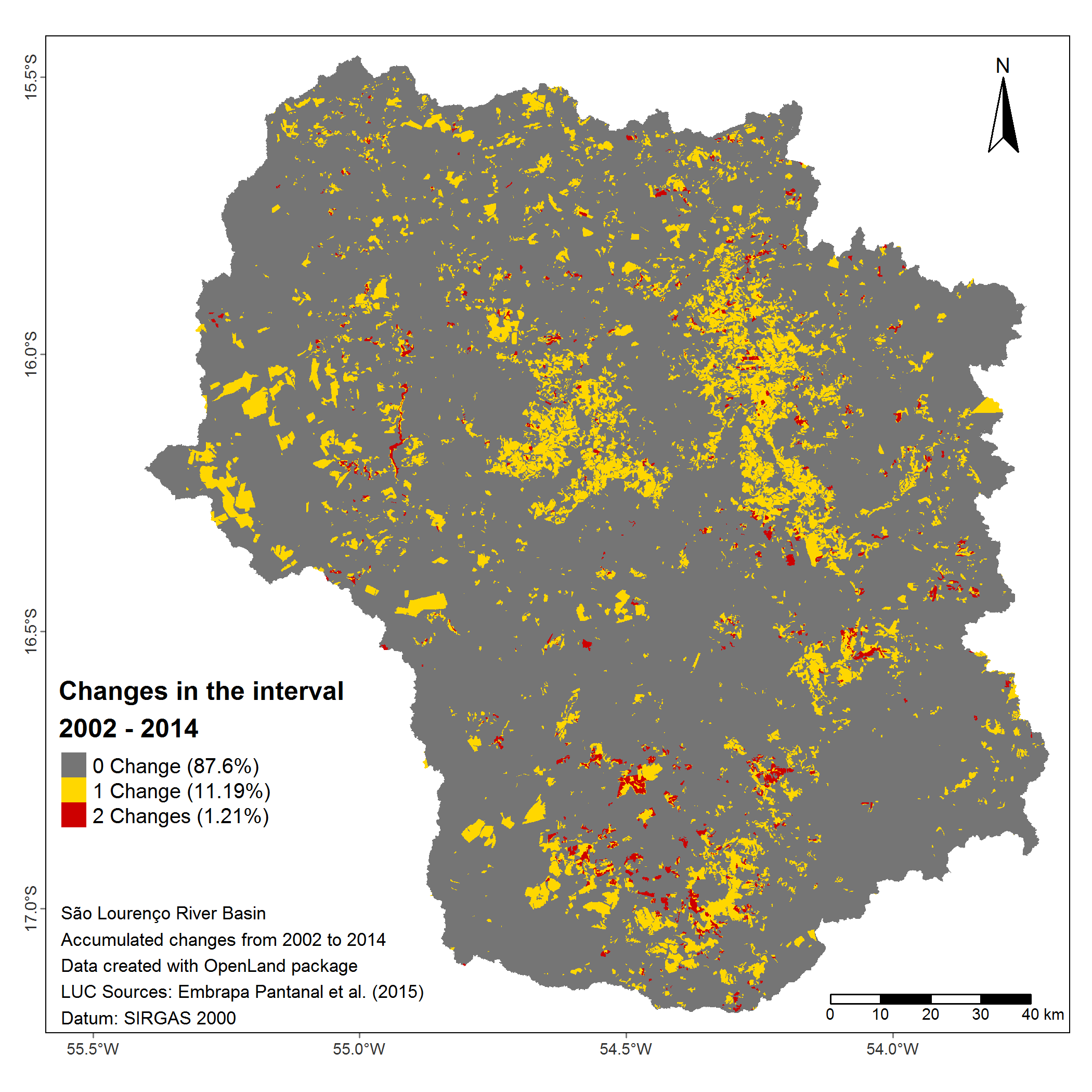
Accumulated changes in pixels in the interval 2002 - 2014 at four time points (2002, 2008, 2010, 2012, 2014)
Aldwaik, Safaa Zakaria, and Robert Gilmore Pontius. 2012. “Intensity analysis to unify measurements of size and stationarity of land changes by interval, category, and transition.” Landsc. Urban Plan. 106 (1): 103–14. https://doi.org/10.1016/j.landurbplan.2012.02.010.
Allaire, J J, Christopher Gandrud, Kenton Russell, and C J Yetman. 2017. “networkD3: D3 JavaScript Network Graphs from R.” https://cran.r-project.org/package=networkD3.
Chambers, John. 2008. Software for Data Analysis. Statistics and Computing. New York, NY: Springer New York. https://doi.org/10.1007/978-0-387-75936-4.
Embrapa Pantanal, Instituto SOS Pantanal, and WWF-Brasil. 2015. “Mapeamento da Bacia do Alto Paraguai.” https://www.embrapa.br/pantanal/bacia-do-alto-paraguai.
Gu, Zuguang, Lei Gu, Roland Eils, Matthias Schlesner, and Benedikt Brors. 2014. “circlize implements and enhances circular visualization in R.” Bioinformatics 30 (19): 2811–2.
Reginal Exavier and Peter Zeilhofer. OpenLand: Software for Quantitative Analysis and Visualization of Land Use and Cover Change. The R Journal, v. 12, n. 2, p. 359–371, 2021. https://doi.org/10.32614/RJ-2021-021.


